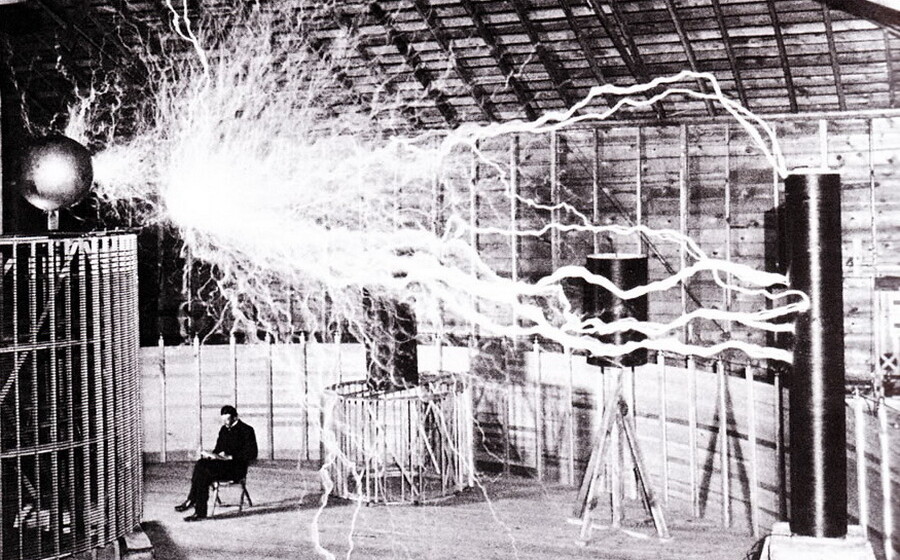Bright Ideas
For a printable version of this article, please click here.
Did you know…
 How many electrical devices do you use every day? From electric lighting to coffee makers, and cell phones to vehicles (even the gas-powered ones use electricity!), our modern society fully depends on electricity for its very existence. We use electricity for our basic needs – lighting, communication, food storage and preparation, and environmental comfort – as well as for entertainment (TVs and gaming systems), transportation (planes, trains, and automobiles), healthcare (MRIs and ultrasounds), chores (dish washers and lawnmowers), and work (construction tools and computers). The basic foundation of these inventions started with simple human curiosity about the world around them, and grew to the creation of electrical devices (and their infrastructures) that we couldn’t live without today.
How many electrical devices do you use every day? From electric lighting to coffee makers, and cell phones to vehicles (even the gas-powered ones use electricity!), our modern society fully depends on electricity for its very existence. We use electricity for our basic needs – lighting, communication, food storage and preparation, and environmental comfort – as well as for entertainment (TVs and gaming systems), transportation (planes, trains, and automobiles), healthcare (MRIs and ultrasounds), chores (dish washers and lawnmowers), and work (construction tools and computers). The basic foundation of these inventions started with simple human curiosity about the world around them, and grew to the creation of electrical devices (and their infrastructures) that we couldn’t live without today.
-
More Info: The War of the Currents
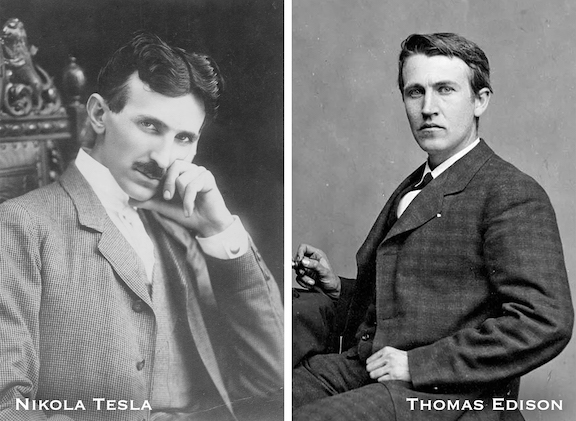 Electrical inventions in the 19th century were consistently a race for first –who could come up with a practical and profitable solution first, who could get the best funding, and who could get their idea patented first. One battle of ideas pitted Thomas Edison, who created the infrastructure for Direct Current (DC), against Nikola Tesla, who created Alternating Current (AC). Their “War of the Currents” may have had some roots in a misunderstanding when Tesla worked for Edison in 1884 – he improved a DC generator design, thinking that Edison had promised to pay $50,000 for the work, only to find that the offer wasn’t real.
Electrical inventions in the 19th century were consistently a race for first –who could come up with a practical and profitable solution first, who could get the best funding, and who could get their idea patented first. One battle of ideas pitted Thomas Edison, who created the infrastructure for Direct Current (DC), against Nikola Tesla, who created Alternating Current (AC). Their “War of the Currents” may have had some roots in a misunderstanding when Tesla worked for Edison in 1884 – he improved a DC generator design, thinking that Edison had promised to pay $50,000 for the work, only to find that the offer wasn’t real.Edison and his company were heavily invested in DC technology and tried to discredit Tesla’s AC power by spreading misinformation about its safety and advocating for the use of DC electricity instead. He even went so far as to publicly electrocute animals using AC power to demonstrate its supposed dangers. Despite his efforts, Tesla ultimately prevailed, along with his funder, industrialist and fellow inventor, George Westinghouse. AC power proved to be more efficient and practical for power distribution over long distances. Westinghouse’s support of Tesla’s AC power technology helped to establish AC power as the standard for electrical power generation and distribution, and his company became a major player in the electric power industry. Eventually even Edison came to this realization, and he too invested in his opponent’s invention.
Though much has been made of the supposed rivalry between Tesla and Edison, the truth is that it was likely overblown. When Tesla’s lab burned down in 1895, Edison provided him with space to set up a temporary lab. After Edison’s death in 1931, Tesla called him a “great genius” responsible for “undying achievements in the interest of humanity.”
-
More Info: Weird Science
For every electrical invention that was of practical use to society or visionary with what it could accomplish, there were many that were either less helpful, strange, or downright dangerous. Here are a few of those:
Edison’s Talking Dolls. (1890)
Having already invented the phonograph in 1877, Thomas Edison was constantly tinkering with his idea, looking to make it better and more marketable. In 1890, he decided to take it into the toy market, selling dolls that had miniaturized phonographs in them that played Twinkle Twinkle Little Star, Jack and Jill, and Hickory Dickory Dock, and more. Unfortunately for Edison, the dolls weren’t popular. They were expensive ($10-$20 in 1890, equaling around $300-$600 today), didn’t work well, fell apart easily, and when the sound did work, it was of poor quality. His toy company ended up being more than $50,000 in debt after this venture (over $1.6 million today), and he turned to other ideas instead.
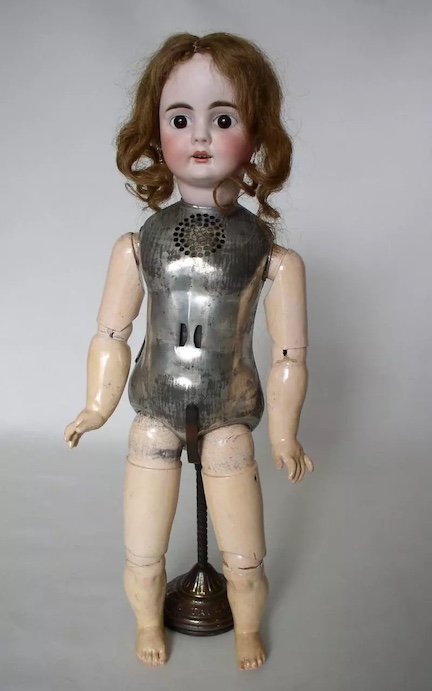
The Good (?) News: You can now listen to restored Edison Talking Doll recordings, 133 years later! The National Park Services has them online at the Thomas Edison National Historic Park, in all their creepy glory.
Edison’s Spirit Phone (1920)
Inspired by the theories of Albert Einstein on special relativity and quantum entanglement, Edison believed that if mass converts into energy, then perhaps the same thing could happen to the spirits of people when they die, and then that energy can go on to interact with the physical world. To test this theory, he built what he called a Spirit Phone, and he and a friend made an agreement that the first to die would contact the other. To our knowledge, no such phone call was made!
Tesla’s Ozone Generator
In 1903, Nikola Tesla was looking for an invention that would make him money and bolster his reputation. To do so, he created an ozone generator, claiming it could clean the very air we breathe inside our homes. He couldn’t have picked a better time, as air pollution caused by burning coal was particularly bad at the turn-of-the-century. Tesla’s generator created molecules of three oxygen atoms, which are also created when lightning strikes, creating a “fresh” smell. The smell made people think their indoor air was truly being cleaned, but in reality they were filling their homes with poison. Ozone, while excellent at blocking Earth from harmful ultraviolet radiation from the sun, also takes electrons from cell walls and destroys the cell’s DNA. Breathing it can cause lung damage and death.
Today, the FDA has declared ozone a toxic gas with no known therapeutic purposes; ozone generators have been approved only for sterilizing water and equipment.
Various Medical Devices
A peek into Victorian medical practices can be disturbing at best. People with little to no medical qualifications invented electrical machines that were said to cure baldness, cancer, dysentery, sexual issues, heart disease, mental disabilities, and more. In reality, they did none of these things, and sometimes hurt or killed the patients they were supposed to help. In our collection, we have two electrical medical devices:
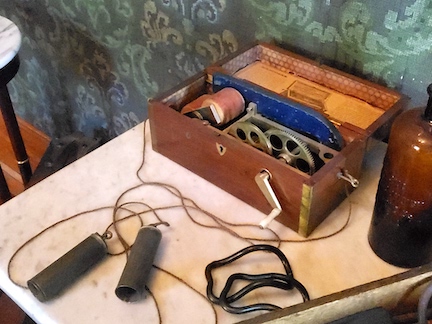 Hall’s Portable Magnetic Machine for Nervous Diseases, c1860s-1870s
Hall’s Portable Magnetic Machine for Nervous Diseases, c1860s-1870s
The price on printed material inside machine indicates it was sold for $10. A crank was turned to generate electricity with a magnet, and the strength of the electric shock depended on how fast the crank was turned. The metal terminals (attached to the crank with wires) were placed on the part of the body needing treatment.RenuLife Violet Ray Health Generator, c1920
A letter that came with these machines lists the price range from $12.50 to $75. It had attachments for internal and external use, and was said to emit a “violet ray” (not ultraviolet) that healed many different kinds of ailments. Our machine only has a couple of attachments remaining, but you can see the entire Electrode Applicators Instructions and Physicians Directions book through the Medical College of Wisconsin Digital Library, and learn all the ways you were supposed to use the Violet Ray (fair warning – it looks supremely uncomfortable in many, many ways).Manufacture of Violet Ray appliances was prohibited in the United States in 1951.
Below you’ll find a timeline we have on display at Phoenix Fan Fusion this weekend (June 2nd-4th) of some of these electrical discoveries and inventions. By no means is this timeline all encompassing – many discoveries/inventions were worked on simultaneously by multiple people across the globe, and then further enhanced over time. For example, though Thomas Edison invented the first practical incandescent lightbulb in 1879, he wasn’t the only person working on creating electrical lighting worldwide – as early as 1809, British chemist Humphrey Davy invented the arc light; in 1874 Canadian inventors Henry Woodward and Mathew Evans patented their version of an incandescent lightbulb (and later sold it to Edison); and in 1878, Joseph Swan patented his incandescent lightbulb in England. Even after Edison patented his lightbulb, his filament was improved by US inventor Lewis Latimer in 1881. Latimer’s invention in turn was improved in 1904 with the creation of the tungsten filament, and that invention was supplanted after the invention of the LED lightbulb in 1962, which has been improved in its turn.
Electricity Timeline through the 1920s:
 600 BCE: In the first historical reference to static electricity, Greek philosopher Thales of Miletus noted that amber attracts feathers and other lightweight materials when rubbed. He also experimented with the lodestone (now called magnetite) and observed that it can attract iron.
600 BCE: In the first historical reference to static electricity, Greek philosopher Thales of Miletus noted that amber attracts feathers and other lightweight materials when rubbed. He also experimented with the lodestone (now called magnetite) and observed that it can attract iron.
43 CE: Greek physician Scribonius Largus uses a live torpedo fish (also known as an electric ray) to treat gout and headaches in his patients.
1751 CE: Benjamin Franklin experiments with lightning, using a kite, a key, and a Leyden jar (an early device used to store an electrical charge). In getting shocked during one of his experiments, Franklin said he felt, “…a universal blow throughout my whole body from head to foot, which seemed within as well as without; after which the first thing I took notice of was a violent quick shaking of my body…” (He also had a feeling of numbness in his arms and the back of his neck that gradually wore off.)
1800 CE: Alessandro Volta invents the first electric battery, known as the voltaic pile. A voltaic pile consists of a series of zinc and copper discs separated by conducting cards, that produce a continuous electric current.
1821 CE: Michael Faraday discovers electromagnetic induction, which forms the basis of electrical generators and transformers.
1831 CE: Joseph Henry develops the electromagnet, which is used in various applications including telegraphy and electric motors.
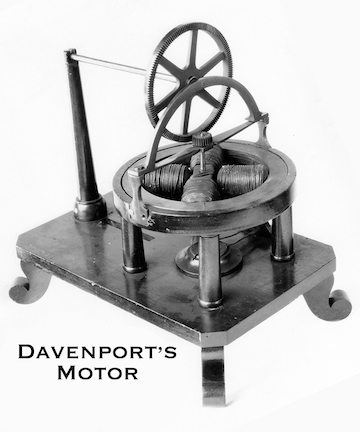 1837 CE: Thomas Davenport builds the first electric motor, using a wooden base and four electromagnets, made to revolve within a ring of steel magnets.
1837 CE: Thomas Davenport builds the first electric motor, using a wooden base and four electromagnets, made to revolve within a ring of steel magnets.
1844 CE: The first telegraph message is sent and received from Washington, DC to Baltimore, MD. Telegraph machines were electrical signaling systems that enabled people to communicate relatively quickly over distances.
1866 CE: Werner von Siemens develops the first dynamo, a device that generates electrical power by converting mechanical energy into electrical energy, and the forerunner of modern, large-scale electric generators.
1876 CE: Alexander Graham Bell is awarded the first US patent for the invention of the telephone. The patent was drawn up by fellow inventor and patent draftsman, Lewis Latimer.
1879 CE: Thomas Edison invents the first practical incandescent light bulb. It was improved by inventor Lewis Latimer in 1881, who modified the process for making carbon filament, reducing breakages during the carbonization process and allowing the lightbulb to last much longer. (Learn more about Lewis Latimer and his innovative life; and read his book, Incandescent Electric Lighting, c1890)
1879 CE: Cleveland, OH was the first city to use electricity to light its streets, using 12 powerful arc lamps (lights using an arc of electrical current between two carbon electrodes to produce light).
1882 CE: The first electric Christmas lights were created, with 80 red, white, and blue lights hand-wired together by Edward H. Johnson, Vice President of Thomas Edison’s Electric Light Company. The tree itself was placed on a rotating platform, and both the platform and lights ran on generator power. Learn more about decorative lights from our blog article, Lighting up the Holidays.
1882 CE: Schuyler Wheeler invents the first electric fan – early mechanical fans included designs that were also powered by water and kerosene.
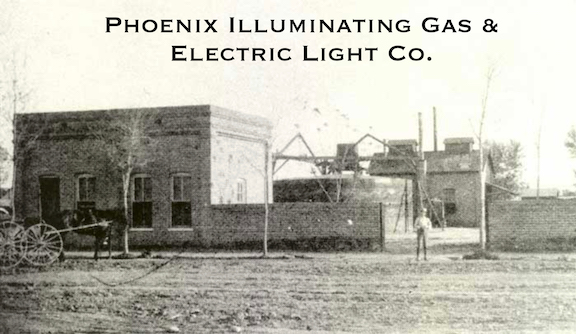 1886 CE: The Phoenix Illuminating Gas & Electric Light Co. was established after three Arizona men (including Japanese immigrant, Hachiro Onuki, who went by Hutchlon Ohnick) were given permission by the City Council to provide Phoenix with gas and electric lighting in April.
1886 CE: The Phoenix Illuminating Gas & Electric Light Co. was established after three Arizona men (including Japanese immigrant, Hachiro Onuki, who went by Hutchlon Ohnick) were given permission by the City Council to provide Phoenix with gas and electric lighting in April.
1888 CE: Nikola Tesla invents the AC (alternating current) motor and develops the AC power distribution system.
Late 1800s: Electricity gets “hands-on” with popular medical devices that claimed to treat abscesses and writers’ cramp, and everything in between.
1891 CE: In August, the Arizona Republican newspaper reports that electricity was only available at night in Phoenix.
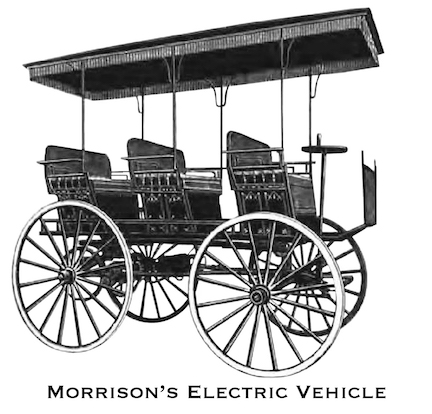 1891 CE: William Morrison of Des Moines, Iowa invents a six-passenger electric wagon that is considered the first practical electric vehicle in the United States. It was created with a specially made 6 seat surrey with space for 24 batteries located under the seats, and could travel up to 14 mph.
1891 CE: William Morrison of Des Moines, Iowa invents a six-passenger electric wagon that is considered the first practical electric vehicle in the United States. It was created with a specially made 6 seat surrey with space for 24 batteries located under the seats, and could travel up to 14 mph.
1895 CE: Rosson House is built, using all electric light fixtures, an electric doorbell, and a telephone. Early light fixtures were operated by pull chains and then by rotary or pushbutton switches. Though homes like Rosson House had electrical lighting, they likely had no electrical outlets, and appliances like our Westinghouse fan would have had to be plugged in using a special adapter for a lightbulb socket. Learn more about the history of telephones by reading our blog, Telephones at the Turn-of-the-Century.
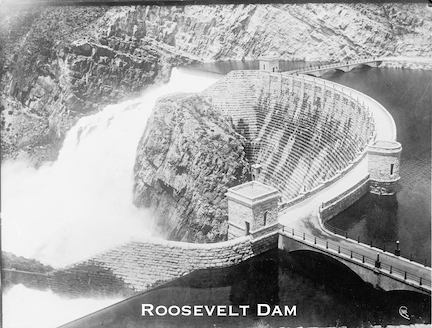 1905 CE: SRP begins producing hydroelectricity at Roosevelt Dam.
1905 CE: SRP begins producing hydroelectricity at Roosevelt Dam.
1913 CE: American Fred Wolfe creates the first electric refrigerator for the home. Called the DOMELRE (short for DOMestic ELectric REfrigerator), it had an air-cooled condenser and compressor that sat on top of the fridge. Learn about the history of food storage by reading our blog article, Can It!.
1922 CE: Willis Carrier invents the first practical air conditioner for the home. It wasn’t until restoration of Rosson House that a whole-house air conditioner was installed in the home – prior to restoration the individuals who lived at Rosson House used either evaporative coolers or window AC units. Today we have 4 central air conditioners to cool the museum – two for each floor (the attic is not air conditioned).
1927 CE: Philo Taylor Farnsworth invents the first rudimentary television, but it wasn’t until the late 1940s (after World War II) that televisions would be produced cheaply enough and become popular with a broader audience.
Header Picture: Nikola Tesla in a publicity photo, showing him sitting with his magnifying transmitter, which can produce millions of volts of electricity. In reality, the picture was produced using double exposure, where the photographer used the same photographic plate to take both pictures. c1899
Learn more about Nikola Tesla by exploring the Nikola Tesla Museum, available online through Google Arts & Culture.
Explore Thomas Edison’s life at the Thomas Edison National Historical Park, also available online through Google Arts & Culture.
Information for this article was found online at: the US Department of Energy, The History of the Light Bulb, The War of the Currents – AC vs DC Power, The History of the Electric Car, and Top 11 Things You Didn’t Know About Nikola Tesla; Smithsonian National Museum of American History, Innovative Lives – Lewis Latimer Renaissance Man; Thomas Edison Center at Menlo Park, About Thomas Edison; Library of Congress, Life of Thomas Alva Edison and Early Electric Cars in America; Smithsonian Magazine, The Unexpected History of the Air Conditioner; Sparkfun, Alternating Current (AC) vs Direct Current (DC); Science History Institute, A Killer of a Cure; the Canadian Encyclopedia, Woodward and Evans Light Bulb; The Franklin Institute, Benjamin Franklin and the Kite Experiment and Franklin’s Lightning Rod; Science Direct, Scribonius Largus; National Park Service, Roosevelt Dam; American Physical Society, This Month in Physics – Arc Lights; Nikola Tesla Museum, Nikola Tesla Chronology; The Electricity Forum, A Timeline of Electricity.
Archive
-
2024
-
July (1)
-
June (1)
-
May (1)
-
April (1)
-
March (1)
-
February (1)
-
January (1)
-
-
2023
-
December (1)
-
November (1)
-
October (1)
-
September (1)
-
August (1)
-
July (1)
-
June (1)
-
May (1)
-
April (1)
-
March (1)
-
February (1)
-
January (1)
-
-
2022
-
December (1)
-
November (1)
-
October (1)
-
September (1)
-
August (1)
-
July (1)
-
June (1)
-
May (1)
-
April (1)
-
-
2021
-
December (1)
-
November (1)
-
October (1)
-
September (1)
-
August (1)
-
July (1)
-
June (1)
-
May (1)
-
April (1)
-
March (1)
-
February (1)
-
January (1)
-
-
2020
-
December (1)
-
November (1)
-
October (1)
-
September (1)
-
August (1)
-
July (1)
-
June (1)
-
May (1)
-
April (1)
-
March (1)
-
February (1)
-
January (1)
-
-
2019
-
December (1)
-
November (1)
-
October (1)
-
September (1)
-
August (1)
-
July (1)
-
June (1)
-
May (1)
-
April (1)
-
March (1)
-
February (1)
-
January (1)
-
-
2018
-
December (1)
-
November (1)
-
October (1)
-
September (1)
-
August (1)
-
July (1)
-
May (1)
-
April (1)
-
March (1)
-
February (1)
-
January (1)
-
-
2017
-
December (1)
-
November (1)
-
October (1)
-
September (1)
-
August (1)
-
July (1)
-
June (1)
-
May (1)
-
April (1)
-
March (1)
-
February (1)
-
January (1)
-
-
2016
-
December (1)
-
-
2015
-
2014
-
July (1)
-
